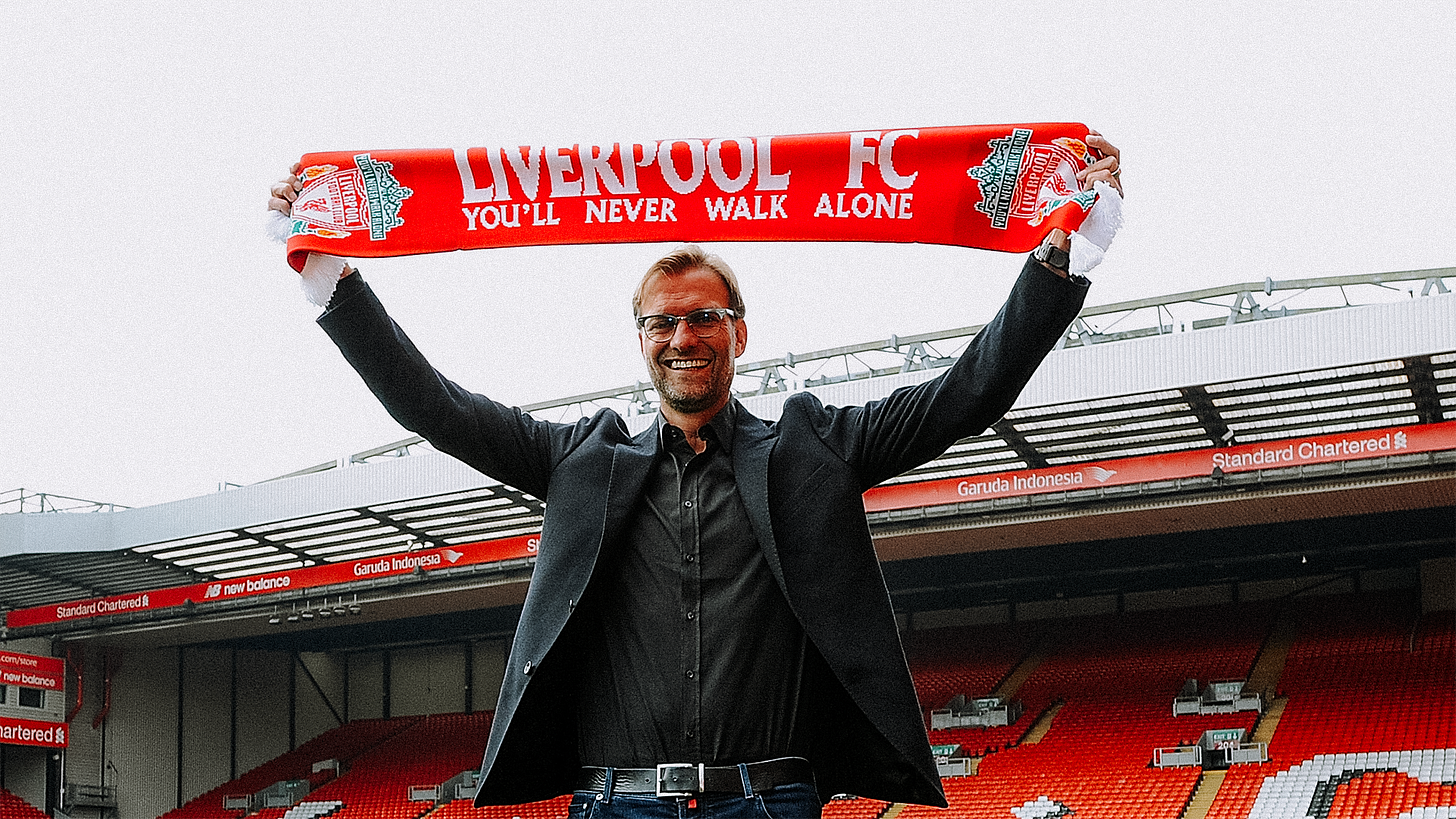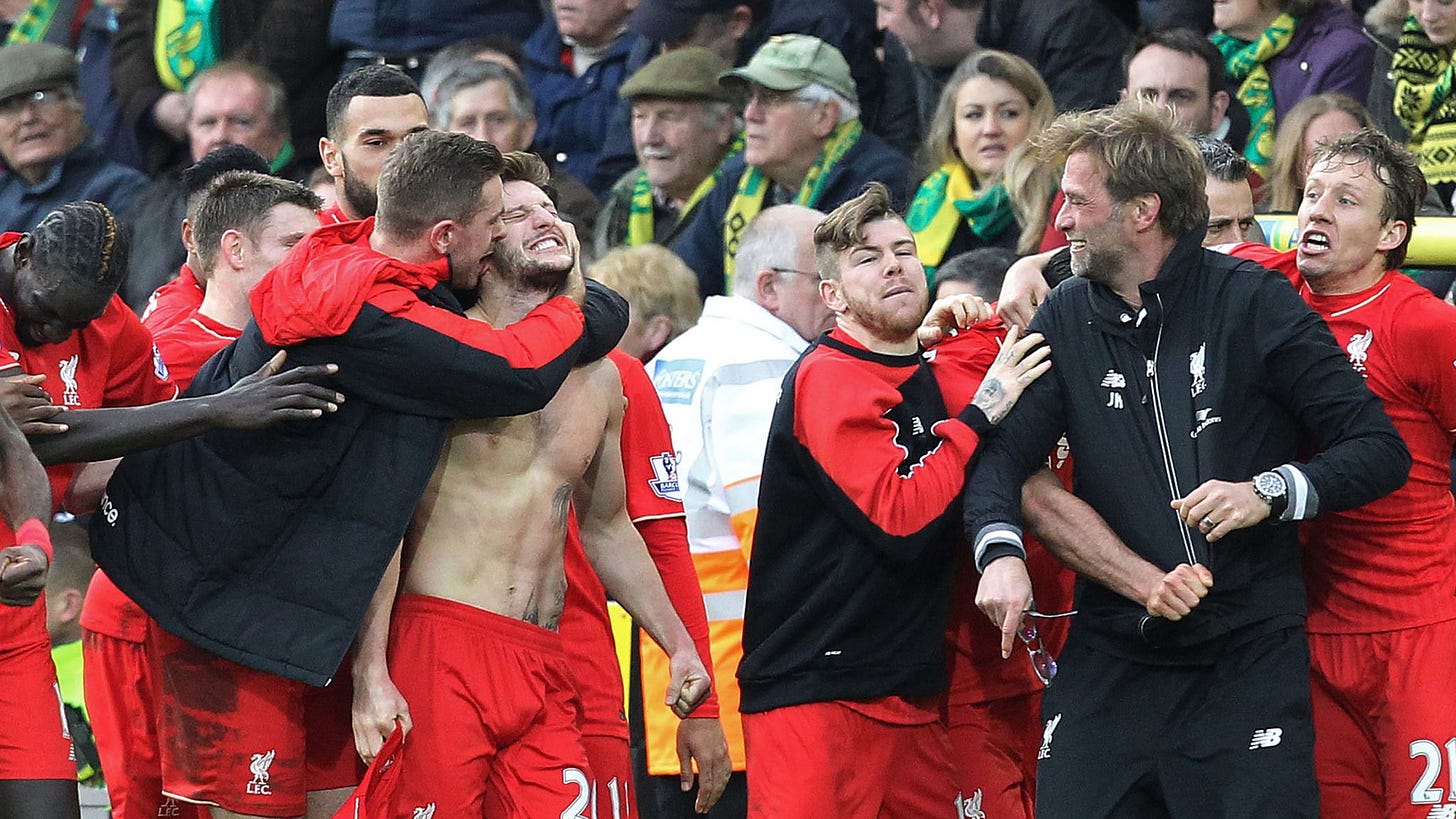Built to Last: Klopp’s Liverpool and the Foundations of a New Dynasty
A forensic look at the rise, reign and lasting legacy of the man who put Liverpool back where it belongs
10 Years On: How Klopp Rebuilt a Broken Liverpool
Ten years ago this week, Jürgen Klopp walked through the doors at Anfield and took charge of a club adrift. His appointment on 8 October 2015 was not just timely; it was necessary. Liverpool were on the verge of losing not just relevance in English football, but their very identity. In the decade since, Klopp’s fingerprints have been imprinted on every inch of the club. Although he left in May 2024, what came after him, including Arne Slot’s title-winning debut season, has grown from the soil Klopp turned over and replanted.
The first phase of that revolution was not silverware or tactics. It was reconstruction. And it began with rubble.
Collapse Before Construction
In 2015, Liverpool were stagnating in the middle of the Premier League table, drifting between ideologies and clinging to past glories with whitening knuckles. Brendan Rodgers had come close to the title in 2014 but that surge collapsed just as quickly as it had risen. The years that followed were marked by failed recruitment, muddled strategy, and a disconnect between what Liverpool wanted to be and what they were.
The squad Klopp inherited was an awkward patchwork. There were players signed for systems the club no longer played, and others who had no business being there at all. There were forwards who did not press, midfielders who could not pass under pressure, and defenders who lacked the positional discipline required at the elite level. It was a team without cohesion or conviction.
More worrying was the cultural rot. Anfield no longer feared visiting strikers. The fear factor was gone. Excuses had replaced ambition. A generation of supporters had grown used to mediocrity, and in some quarters, accepted it.
What Klopp stepped into was not a club on the brink of greatness. It was a proud institution in danger of losing its soul. His first job was not to win trophies, it was to remind everyone what Liverpool stood for.
Restoring Identity
The football did not improve overnight. His first match, a goalless draw away at Tottenham, was forgettable. But in Klopp’s body language, in his defiance on the touchline, in his refusal to allow standards to slip even for a second, something changed. It was not a new era, but a new expectation.
He spoke about turning doubters into believers. It sounded like a throwaway line at the time, but it became a mission statement. From the outset, Klopp preached effort, togetherness, and intensity. His players were to run and suffer and press until their lungs begged for mercy. This was not about possession for possession’s sake. This was about forcing the issue, about demanding the ball back and demanding more from each other.
He cleared out what needed to be cleared. There were no sacred cows. Players who did not fit were moved on, and those who stayed knew they had to buy in or step aside. The early signings reflected the plan. Sadio Mané, Georginio Wijnaldum, Joel Matip, and others were not global superstars when they arrived, but they were athletes and grafters with intelligence and humility. They were Liverpool players in the truest sense.
He also reconnected the club with its roots. Klopp understood Liverpool’s working-class heritage. He recognised that this was a club built not on money or media, but on effort and unity. His style of football reflected the city, sharp and uncompromising, full of noise and heart. The bond between the team and the supporters, which had frayed in recent years, was repaired by shared belief and shared purpose.
Building Blocks in Place
Results were inconsistent in that first season, but there were moments that lit a spark. The 5-4 win at Norwich, sealed by a scruffy last-minute strike from Adam Lallana, was chaos made perfect. The comeback against Borussia Dortmund at Anfield, capped by Dejan Lovren’s improbable header, was one of the great European nights in the club’s history. Neither game delivered silverware, but both reminded supporters what it felt like to belong to something.
Klopp’s side lost two finals in that debut campaign, the League Cup and the Europa League, but by the end of the season the transformation was visible. The team was not just fitter, it was more focused. There was a clear plan. Everyone knew their role. And everyone knew who was in charge.
Away from the pitch, the rebuild was just as important. Klopp supported the restructuring of Liverpool’s recruitment system. He worked closely with the club’s analysts and sports science teams. The approach to transfers changed completely. No more short-term punts or overpriced names. Now it was about character, output, and fit. The signings that followed, from Mohamed Salah to Andrew Robertson to Virgil van Dijk, were calculated moves that fed into a larger vision.
Even Klopp’s coaching staff was handpicked for alignment. He surrounded himself with people who shared his philosophy but who also challenged him when needed. There were no yes-men. There was scrutiny and dialogue. He did not seek control for control’s sake, he sought clarity.
Foundation for the Future
By the end of his second season, Klopp had laid the groundwork. The football was sharper, the energy relentless, and the atmosphere inside Anfield had turned once again from cautious hope to confident roar. Liverpool were not yet champions, but they were competitors again. The world was watching.
Klopp had returned the club to itself. Not through a flurry of titles, but through a restoration of values. He reminded Liverpool who they were and showed them who they could become. That is what a rebuild really looks like. It is not paint on peeling walls. It is new bricks and new mortar and a new sense of direction.
Ten years after his arrival, Klopp is no longer in the dugout. But the house he built still stands. And it stands firm.
The Rise: Defining Games, Players, and Turning Points in Klopp’s Liverpool
Every great era has its spark, its turning point, its faces. For Jürgen Klopp’s Liverpool, the rise from contenders to champions did not come by accident or fortune. It came from key decisions, iconic nights, and players who embodied the project in both style and substance.
This was not a linear climb. It was a charge full of sweat, setbacks, and moments of astonishing clarity. Klopp took Liverpool from a club with fractured ambitions to a force that bent footballing logic. Here is how the rise took shape.
The Arrival of Leaders, Game Changers, and Architects
The transfer strategy under Klopp was precise. Every player was signed for a reason. Not just to fill a gap, but to fulfil a role within a growing identity. There were no vanity projects. Each signing either solved a problem or elevated the system.
Sadio Mané was the first real signal of intent. Quick, intelligent, relentless. He pressed like a man with a point to prove and finished like a forward with years of pedigree. Mohamed Salah followed, dismissed by some as a Chelsea castoff, only to rewrite scoring records and redefine what it meant to play wide in a front three.
Virgil van Dijk changed everything. He brought presence, composure, and command to a defence that had been built on nerves and compromise. His £75 million fee raised eyebrows at the time. Within months, it felt like a bargain. With van Dijk at the back and Alisson Becker behind him, Liverpool went from brittle to bulletproof.
Fabinho added balance. Andy Robertson brought hunger. Trent Alexander-Arnold, a product of the academy, offered invention from deep. This was not a collection of stars. This was a football team built for cohesion, aggression, and control.
Every piece mattered. Every piece had a purpose.
Dortmund, Norwich, and the Belief That Followed
Long before the trophies came, belief had to be restored. That belief was built not in finals, but in nights that felt like something bigger was unfolding.
The 4-3 win over Borussia Dortmund in the Europa League stands among the most remarkable matches ever played at Anfield. Liverpool were 2-0 down after nine minutes, 3-1 down with 30 minutes left, and needed three goals to go through. They got them. Philippe Coutinho sparked it, Mamadou Sakho equalised, and Dejan Lovren, of all people, scored the winner in stoppage time.



